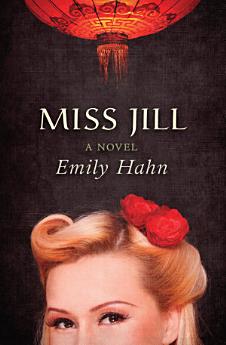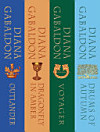Miss Jill: A Novel
აპრ. 2014 · Open Road Media
ელწიგნი
221
გვერდი
family_home
მისაღები
info
reportრეიტინგები და მიმოხილვები დაუდასტურებელია შეიტყვეთ მეტი
ამ ელწიგნის შესახებ
A novel about an enterprising Shanghai streetwalker from the “American literary treasure” and author of the memoir China to Me (The New Yorker).
Meet Miss Jill, a young woman pursuing the oldest profession in prewar Shanghai. Fifteen, blonde, and full of personality, Jill begins her career as a Japanese banker’s mistress. Soon after, she becomes a European prostitute in the house of Annette, and believes that any day now she’ll be married to a nobleman. But none of her adventures prepare Miss Jill for the war and her subsequent internment.
An early feminist and an American journalist who traveled to the Belgian Congo and China in the 1930s, Emily Hahn wrote more than fifty books, both fiction and nonfiction; this is Hahn at her touching and entertaining best, portraying an exotic place in a dramatic time with great authenticity and empathy.
Meet Miss Jill, a young woman pursuing the oldest profession in prewar Shanghai. Fifteen, blonde, and full of personality, Jill begins her career as a Japanese banker’s mistress. Soon after, she becomes a European prostitute in the house of Annette, and believes that any day now she’ll be married to a nobleman. But none of her adventures prepare Miss Jill for the war and her subsequent internment.
An early feminist and an American journalist who traveled to the Belgian Congo and China in the 1930s, Emily Hahn wrote more than fifty books, both fiction and nonfiction; this is Hahn at her touching and entertaining best, portraying an exotic place in a dramatic time with great authenticity and empathy.
ავტორის შესახებ
A revolutionary woman for her time and an enormously creative writer, Emily Hahn broke all of the rules of the 1920s, including by traveling the country dressed as a boy, working for the Red Cross in Belgium, being the concubine to a Shanghai poet, using opium, and having a child out of wedlock. Hahn kept on fighting against the stereotype of female docility that characterized the Victorian era and was an advocate for the environment until her death at age ninety-two.
Emily Hahn (1905–1997) was the author of fifty-two books, as well as one hundred eighty-one articles and short stories for the New Yorker from 1929 to 1996. She was a staff writer for the magazine for forty-seven years. She wrote novels, short stories, personal essays, reportage, poetry, history and biography, natural history and zoology, cookbooks, humor, travel, children’s books, and four autobiographical narratives: China to Me (1944), a literary exploration of her trip to China; Hong Kong Holiday (1946); England to Me (1949); and Kissing Cousins (1958).
The fifth of six children, she was born in St. Louis, Missouri, and later became the first woman to earn a degree in mining engineering at the University of Wisconsin. She did graduate work at both Columbia and Oxford before leaving for Shanghai. She lived in China for eight years. Her wartime affair with Charles Boxer, Britain’s chief spy in pre–World War II Hong Kong, evolved into a loving and unconventional marriage that lasted fifty-two years and produced two daughters. Emily Hahn’s final published piece in the New Yorker appeared in 1996, shortly before her death.
Emily Hahn (1905–1997) was the author of fifty-two books, as well as one hundred eighty-one articles and short stories for the New Yorker from 1929 to 1996. She was a staff writer for the magazine for forty-seven years. She wrote novels, short stories, personal essays, reportage, poetry, history and biography, natural history and zoology, cookbooks, humor, travel, children’s books, and four autobiographical narratives: China to Me (1944), a literary exploration of her trip to China; Hong Kong Holiday (1946); England to Me (1949); and Kissing Cousins (1958).
The fifth of six children, she was born in St. Louis, Missouri, and later became the first woman to earn a degree in mining engineering at the University of Wisconsin. She did graduate work at both Columbia and Oxford before leaving for Shanghai. She lived in China for eight years. Her wartime affair with Charles Boxer, Britain’s chief spy in pre–World War II Hong Kong, evolved into a loving and unconventional marriage that lasted fifty-two years and produced two daughters. Emily Hahn’s final published piece in the New Yorker appeared in 1996, shortly before her death.
შეაფასეთ ეს ელწიგნი
გვითხარით თქვენი აზრი.
ინფორმაცია წაკითხვასთან დაკავშირებით
სმარტფონები და ტაბლეტები
დააინსტალირეთ Google Play Books აპი Android და iPad/iPhone მოწყობილობებისთვის. ის ავტომატურად განახორციელებს სინქრონიზაციას თქვენს ანგარიშთან და საშუალებას მოგცემთ, წაიკითხოთ სასურველი კონტენტი ნებისმიერ ადგილას, როგორც ონლაინ, ისე ხაზგარეშე რეჟიმში.
ლეპტოპები და კომპიუტერები
Google Play-ში შეძენილი აუდიოწიგნების მოსმენა თქვენი კომპიუტერის ვებ-ბრაუზერის გამოყენებით შეგიძლიათ.
ელწამკითხველები და სხვა მოწყობილობები
ელექტრონული მელნის მოწყობილობებზე წასაკითხად, როგორიცაა Kobo eReaders, თქვენ უნდა ჩამოტვირთოთ ფაილი და გადაიტანოთ იგი თქვენს მოწყობილობაში. დახმარების ცენტრის დეტალური ინსტრუქციების მიხედვით გადაიტანეთ ფაილები მხარდაჭერილ ელწამკითხველებზე.







